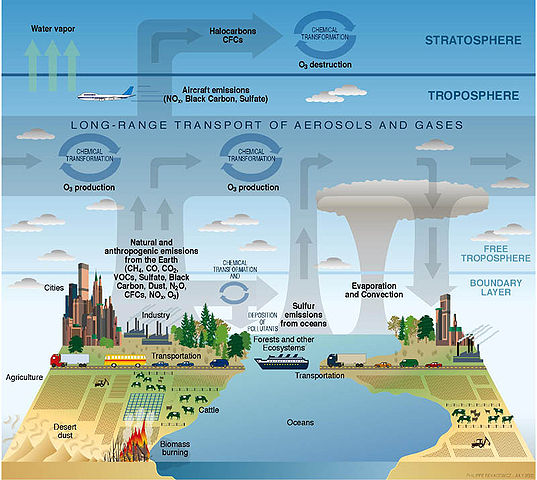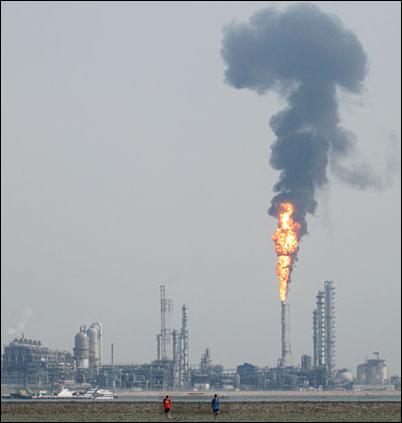Atmospheric science

The evolution and/or cycles of various elements in Earth's atmosphere[1]
Atmospheric science is the umbrella term for the study of the atmosphere – the blanket of air covering the Earth.
It is a relatively new discipline that is concerned with the composition, structure and evolution of the atmosphere as well as its processes and how those processes interrelate with other systems.[2][3][4]
The adjacent image depicts the various processes occurring in the atmosphere and how they relate to other Earth systems such as agriculture, land, sea and air transportation, other ecosystems, air pollutant emissions, the water cycle (evaporation and rainfall), forests and forest fires, deserts and desert dust, industry, etc.
To the extent that atmospheric science focuses primarily on the Earth's atmosphere, it can be regarded as a subfield of the Earth sciences, each of which is a particular synthesis of the fundamentals of physics, chemistry, fluid dynamics and thermodynamics.
What atmospheric science includes
Atmospheric science includes a number of primary subdisciplines as briefly discussed further in this section.[5]
Atmospheric chemistry
Atmospheric chemistry is the study of the chemistry of Earth's atmosphere. It is a multidisciplinary field that draws on physics, meteorology, environmental chemistry, oceanography and volcanology. The composition and chemistry of the atmosphere is important because of the interactions between the atmosphere and living organisms.
The composition of the atmosphere has been changed by human activity and some of those changes have created problems for human health, agricultural crops and ecosystems. Some examples of such problems are acid rain, smog, the greenhouse effect and ozone depletion (often referred to as the ozone hole). Atmospheric chemistry seeks to understand such problems and perhaps find possible solutions for them.
Atmospheric dynamics
Atmospheric dynamics is the study of all motion systems of meteorological importance. It includes such diverse phenomena as thunderstorms, tornadoes, hurricanes, tropical cyclones, jet streams and global-scale circulations.[6]
The goal of studying atmospheric dynamics is to explain the observed motion systems on the basis of fundamental principals of physics. The benefits that would accrue would include improving weather forecasting and better predictions of the occurrences of devastating tornadoes, hurricanes, and cyclones.
Meteorology
Meteorology is the interdisciplinary scientific study of the processes and phenomena of the atmosphere and it involves atmospheric chemistry, atmospheric physics and weather forecasting.[7][8] The primary subfields of meteorology include:
- Weather forecasting: prediction of the state of the atmosphere for a given location at a given time.
- Atmospheric dynamics: the study of all motion systems of meteorological importance such as thunderstorms, tornadoes, tropical cyclones, jet streams and global-scale circulations.
- Aviation meteorology: studying the effects of weather conditions on the control of air traffic.
- Agricultural meteorology: studying of the effects of weather and climate conditions on agriculture.
- Hydrometeorology: a combination of hydrology and meteorology focused the hydrologic cycle and the water budget as well as forecasts and statistics of heavy rainfall and heavy snow storms.
- Air pollution dispersion modeling: the mathematical simulation of how air pollutants disperse in the ambient atmosphere. It is performed with computer programs, called dispersion models, that solve the mathematical equations and algorithms which simulate the pollutant dispersion.
- Maritime meteorology: deals with wind and wave forecasts for ships operating at sea.
As of 2011, about 34 percent of atmospheric scientists in the United States of America are employed by the U.S. federal government, mostly in the National Weather Service. Many of the other atmospheric scientists are working as researchers in the various subdisciplines of atmospheric science.[4]
Air pollution

Flare stack at petroleum refinery in Singapore. Example of an air pollution emission source.
Air pollution includes chemicals and particulate matter introduced into the atmosphere that cause harm or discomfort to humans or other living organisms, or damage the environment. Air pollution is the major cause of acid rain and smog.
The anthropogenic and natural sources sources of air pollution are discussed in the Air pollution emissions article. In addition, the U.S. Environmental Protection Agency (U.S. EPA) has published an extensive list of air pollution emission factors for a great many industries as discussed in the AP 42 Compilation of Air Pollutant Emission Factors article. The transport and dispersion of air pollution plumes can be predicted with computer programs, called "dispersion models", which simulate how air pollutants disperse in the atmosphere. How such models work is explained and discussed in the Air pollution dispersion modeling article.[9][10] Such models are used to estimate the downwind concentration of air pollutants emitted from industrial plants and vehicular traffic. The dispersion models require the input of data which includes:
- Meteorological conditions such as wind speed and direction, the amount of atmospheric turbulence (as characterized by what is referred to as the stability class), the air temperature and the height to the bottom of any temperature inversion that may be present aloft.
- Emissions parameters such as source location and height, source vent stack diameter and exit velocity, exit temperature and mass flow rate.
- Terrain elevations at the source location and at the receptor location.
- The location, height and width of any obstructions (such as buildings or other barriers) in the path of the gaseous emission plume.
Many of the modern, advanced dispersion modeling programs include a pre-processor module for the input of meteorological and other data, and many also include a post-processor module for graphing the output data and/or plotting the area impacted by the air pollutants on maps. It should be noted that air pollution dispersion modeling also falls within the scope of the meteorology subdiscipline of atmospheric science.
Climatology
Climatology is the study of long- and short-term climate trends (or changes) due to natural and anthropogenic causes. It is a combination of hydrology, geology, meteorology and other fields.[11]
Paleoclimatology, a subfield of climatology, seeks to reconstruct past climates by examining records such as ice cores and tree rings. Contemporary (short-term) weather forecasting uses meteorological data accumulated over many years (e.g., records of rainfall, temperature and atmospheric composition) and models that incorporate those data.
Global warming is a major focus of climatology and is studied to determine its causes and potential effects.
Hydrology
Hydrology is the study of the movement, characteristics and distribution of seawater, surface-water and groundwater.
The primary subfields of hydrology include:
- Chemical hydrology: the study of the chemical characteristics of water.
- Drainage basin management: water-storage in the form of reservoirs, and flood-protection.
- Ecohydrology: the study of interactions between living organisms and the hydrologic cycle.
- Hydrogeology: the study of the presence and movement of ground water.
- Hydrometeorology: the study of the transfer of water and energy between land and water body surfaces and the lower atmosphere.
- Surface hydrology: the study of hydrologic processes that operate at or near Earth's surface.
- Water quality: the study of the chemistry of water rivers and lakes including pollutants and natural solutes.
Oceanography
Oceanography is the study of the Earth's oceans. It is a sub-discipline of Earth science. Seventy percent of the earth's surface is covered by oceans and they encompass many diverse environments. Research is performed on scales ranging from small water drops to entire ocean basins.
The primary subfields of oceanography include:
- Biological oceanography (or marine biology): the study of the plants, animals and microbes of the oceans and their ecological interaction with the ocean.
- Chemical oceanography (or marine chemistry): the study of the chemistry of the ocean and its chemical interaction with the atmosphere.
- Geological oceanography (or marine geology): the study of the geology of the ocean floor including volcanology, plate tectonics, paleoceanography and sedimentation processes.
- Physical oceanography (or marine physics): the study of the oceans' physical attributes including temperature-salinity structure, mixing, waves, tides, and currents.
There is also the field of ocean engineering which involves the design, construction, and installation of various instruments and vehicles to be used in oceanographic studies.
Aeronomy
Aeronomy is the study of the upper layers of Earth's atmosphere where dissociation and ionization are important.[12] During these processes, solar radiation separates neutral atoms, molecules, and chemical compounds into positive and negative particles. This occurs in atmospheres around the Earth, other planets, comets, and satellites.
In general, aeronomy is the science that studies all planetary atmospheres in which physical and chemical processes, resulting from the dissociation and ionization processes under the influence of solar radiation, are important.
Research in aeronomy requires access to balloons, satellites, and sounding rockets which provide valuable data about this region of the atmosphere. Aeronomy research directly applies to the study of global climate change, satellite communication systems, global positioning system (GPS) accuracy, and the interactions of space phenomena with terrestrial power distribution systems.[13]
Planetary science
Planetary science is the study of planets, moons, and planetary systems, in particular those of the Solar System and how they were created. It studies objects ranging in size from very small meteoroids to gas giants, seeking to determine their composition, dynamics, formation, interrelations and history. It is an intensely interdisciplinary field, originally drawing from astronomy and Earth science.
References
- ↑ The 2003 Strategic Plan for the U.S. Climate Change Science Program (CCSP). Figure 3-1, created by Philippe Rekacewicz.
- ↑ Peter V. Hobbs and John M. Wallace (2006). Atmospheric Science: An Introductory Survey, 2nd Edition. Academic Press. ISBN 0-12-732951-X.
- ↑ A. Chandrasekar (2010). Basics of Atmospheric Science. PHI Learning. ISBN 81-203-4022-1.
- ↑ Jump up to: 4.0 4.1 Bureau of Labor Statistics: Occupational Outlook Handbook, 2010-11 Edition: Atmospheric Scientists
- ↑ Discovering the Atmospheric Sciences, From the website of the University Corporation for Atmospheric Research (UCAR)
- ↑ Dale Durran, Gregory Hakim and. Dargan Frierson. Atmospheric Dynamics. University of Washington.
- ↑ W.K. Hamblin and E.H. Christiansen (2003). Earth's Dynamic Systems, 10th Edition. Prentice Hall. ISBN 0-13-142066-6.
- ↑ F.K. Lutgens and E.J.Tarbuck (1991). The Atmosphere: A Introduction to Meteorology, 5th Edition. Prentice Hall. ISBN 0-13-051475-6.
- ↑ Milton R. Beychok. (2005). Fundamentals of Stack Gas Dispersion, 4th Edition. Author-published. ISBN 0-9644588-0-2.
- ↑ Karl B. Schnelle, Jr. and Partha R. Dey (2000). Atmospheric Dispersion Modeling Compliance Guide. McGraw-Hill. ISBN 0-07-058059-6.
- ↑ Robert V. Rohli and Anthony J. Vega (2011). Climatology, 2nd Edition. Jones & Bartlett Learning. ISBN 0-7637-9101-6.
- ↑ Sydney Chapman (1960). The Thermosphere - the Earth's Outermost Atmosphere. Academic Press. ISBN 0-12-582050-X.
- ↑ What is aeronomy?. From the website of Aeronomy.org.
- Pages using ISBN magic links
- CZ Live
- Chemistry Workgroup
- Physics Workgroup
- Engineering Workgroup
- Chemical Engineering Subgroup
- Environmental Engineering Subgroup
- Articles written in American English
- All Content
- Chemistry Content
- Physics Content
- Engineering Content
- Chemical Engineering tag
- Environmental Engineering tag